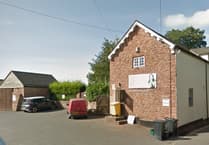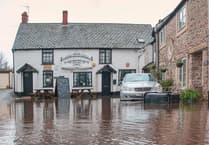I am always interested in finding out more about the way people lived in West Somerset in the past, so I was delighted when I came across a transcript of the will of Grace Escott, widow of Thomas Escott, who lived at Sandhill in the parish of Withycombe during the first part of the eighteenth century. Her husband died when he was just 56 in 1765 and his will, and the inventory of his possessions which we looked at in this column some years ago, shows him to have been a very wealthy man. Grace herself, who was before her marriage, I believe, Grace Tripp of Selworthy, was an heiress in her own right.
The inventory of Thomas's property begins with a valuation of his wearing apparel and silver watch and a note of the cash held in the house – £65 5s – a large sum when the average wage for a live-in servant was £2 a year plus board and lodging.
Banking was in its infancy at the time and an account, further on in the document, of 'moneys due to the deceased on mortgages, bonds and notes of hand' shows that Thomas Escott loaned much-needed cash to many local farmers and businessmen.
The contents of the house were listed room by room and extend to the farm buildings, horses cattle, wagons and so on. But it was the house, of course, that was Grace's domain and here she would, with the help of several servants, have organised the day-to-day life of a large working farmhouse.
The kitchen was furnished with a long table, a settle by the fire, forms and a chair for the head of the table. Cooking was done over an open fire with an oven at the side for baking bread, cakes and pies. Huge joints would have been roasted with the help of a jack, five spits, 'billows', tongs, iron dogs and a dripping pan.
There were plenty of bell metal (an alloy of copper and tin) pots and kettles. Some 102 pewter dishes and plates were stored in dish and trencher cages and on the two huge dressers, which also held sieves and other equipment including eight iron candlesticks. A rack on the wall held five guns.
The little parlour seems to have been the farm office for, besides table-boards and chairs, there was a 'buroe' and some books.
The hall, once the main room of the house, was furnished with more table boards, chairs and joint stools – a reminder that meals were provided every day, not only for the family and inside servants, but for outside servants as well.
More valuable property was also kept in this room: a clock, a pestle and mortar for crushing spices, two coffee pots, more candlesticks, brassware and a tea chest.
This would have been a small wooden box divided into compartments where the precious tealeaves, bought at an exorbitant price, could be locked away. Spices, too, were probably kept in a lockable corner cupboard.
There were more table boards and chairs in the parlour, but no other furniture so I imagine that the silverware – spoons, tankard, salts, cream pot, pepper box, stand for mustard and punch ladle – together with the glasses, were stored in built-in cupboards.
On the walls hung a looking glass, a weather glass and two pictures.
Grace's own silverware and furniture would have enhanced all this. It is listed in her will, dated 6 August 1784 by which time she was living in Dunster.
The first part of the document deals with land and houses in Alcombe, Tivington, Kents in Selworthy and part of the Manor of Blackford and there are a number of bequests of money but it is her personal goods, shared among cousins, nieces and friends, that I find most interesting.
These included six silver tea spoons marked G E, her silver tea tongs, best set of china, china milk jug, stand, tea-table and one of her hand waiters made of oak, all of which she left to Mary, daughter of Robert and Ann Sage.
Her silver butter dish marked T T 1753, an elbow mahogany chair and two single chairs went to Ann, wife of Giles Bryant.
Mary, wife of John Staddon, inherited her half-pint silver cup and a large brass pot while to Ann, daughter of Robert Siderfin, there was a larger bequest – a blue bed, curtains, 'valeons', pillows, quilt, pair of sheets, a pair of blankets and a damask table cloth marked T as well as six blue and white china plates, her large common Prayer Book, another book 'Christian Defence' and a little Bible together with a gilt vessel, a trunk covered with flowered silk, a green bed rug, two silver tablespoons marked T & I T & G T 1724 and a silver-gilt cased knife and fork.
To Mary, daughter of Robert Siderfin, went her silver pint cup marked T T 1753 and all the rest of her silver spoons and her books.
Then came her clothes! These included a flowered silk damask pink gown, a yellow silk quilted petticoat, a fashionable green silk gown, a black silk quilted petticoat.
To Ann Sage, she left her second-best grey mourning silk gown, a blue silk quilted petticoat and two pairs of stays while to Mary Siderfin she left her other green silk gown and a shaded silk quilted petticoat.
Other bequests included a silver brooch marked T T G 1684, a light-coloured silk gown, a striped silk quilted petticoat and silver buckles.
Little imagination is needed to appreciate the style in which Grace lived after she was widowed!



